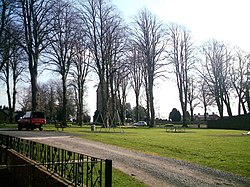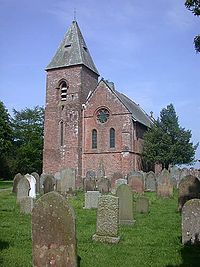Walton, Cumberland
| Walton | |
| Cumberland | |
|---|---|
 Walton Village Green | |
| Location | |
| Grid reference: | NY520644 |
| Location: | 54°58’19"N, 2°44’59"W |
| Data | |
| Population: | 277 (2011) |
| Post town: | Brampton |
| Postcode: | CA8 |
| Dialling code: | 016977 |
| Local Government | |
| Council: | Cumberland |
| Parliamentary constituency: |
Penrith and The Border |
Walton is a village in the far north of Cumberland, ten miles from Carlisle and about two miels north of Brampton, on the north bank of the River Irthing. Nearby villages include Newtown, Banks and Lanercost.
The 2001 census recorded 278 people living in Walton.
Description
Walton, as its name suggests, stands by the course of Hadrian's Wall: the Roman wall skirts the village to its south. In the past, Walton comprised two separate townships; Low Walton and High Walton.[1] However Low Walton and High Walton have now combined to create a single area.[1]
William Ford mentions Walton in his writing when travelling around the Lake District. He writes "the village of Walton, on the line of the wall, as its name denominates..."[2]

The Village
Walton has a church and a village hall. The village hall was used as a school, in the National Gazetteer in 1868 it says that the village hall was also used for a Sunday school.[3] However, in the present day, the village hall is no longer used as a school and its main purpose is to provide the village with a post office. The closest school to Walton is William Howard School in Brampton, 2 miles away from the parish. The village has no shops, the nearest shop for residents in Walton to use is in Brampton, which is 2 and a half miles from the village. The residents of Walton depend greatly on Brampton for their health. The nearest doctors surgery and dentist are both in Brampton. There used to be a pub named "The Centurion" in Walton, however it is now closed.
St Mary's Church

The church in Walton is St Mary's Church, with an active Anglican congregation. The church was built in 1869 on the site of a mediæval church.[4]
The church was designed in a Gothic style by the architects Paley and Austin who were based in Lancaster.[5] In 1901, the church consists of a chancel, nave, north aisle, a tower and a porch. Within the s church, there are brass plaques set into the floor, commemorating the Johnson family, who occupied Castlesteads mansion. The plaques date from 1821 to 1865.[4]
Castlesteads Mansion
Castlesteads Mansion in Walton is a grade II building.[6] It was built at the end of the 18th century by the Johnson family. It is believed that the estate was previously owned by the Dacre family who built "Walton House" using bricks from the nearby Hadrian's Wall. The Johnson family purchased the estate in 1789 and replaced "Walton House" with a larger mansion, known as Castlesteads. It is located on an old Roman fort called the Cambeck fort of Camden.[7] The mansion is south east of Walton and is surrounded by 75 acres of woods, it also looks over the River Irthing. In 1839, William Ford described Castlesteads in his journal as being "an elegant and modern residence." At the time of this description Castlesteads was known as "Walton House" and was occupied by William Johnson. Ford also states that many "Roman remains" were dug up and are preserved at Castelesteads.
Hadrian's Wall

One of the main features which draws people to the village is its historical past. The parish stands on the route of Hadrian's Wall.[1] The remains of the Roman wall can still be seen near Walton today, and it is thought that the village is situated at the site of one of the milecastles of Hadrian's Wall, Milecastle 56.[8] It is said that many of the old cottages and buildings are made from the stones taken from the Roman wall.[1] A National Trail named Hadrian's Wall Path was opened in May 2003 in Walton. However, the section of Hadrian's wall closest to Walton has been covered to protect it. The public can view an exposed section of the wall near the hamlet of Banks, about five miles east of Walton.
In the 19th Century, James Steele of Walton, a blind poet, as well as a social reformer, teacher and a musician, wrote a poem regarding Walton and the presence of Hadrian's Wall. It includes the passage: "Walton on the Roman Wall, fairest village of them all, rivers three around thee flow, clearest streams man may know."
Outside links
| ("Wikimedia Commons" has material about Walton, Cumberland) |
References
- ↑ 1.0 1.1 1.2 1.3 Walton through time (Vision of Britain)
- ↑ Ford, William: 'A Description of Scenery in the Lake District' (Charles Thurnham, 1839)
- ↑ Genuki. (2012)
- ↑ 4.0 4.1 National Heritage List 1157868: Church of St Mary
- ↑ Price, James (1998), Sharpe, Paley and Austin: A Lancaster Architectural Practice 1836–1942, Lancaster: Centre for North-West Regional Studies, p. 88, ISBN 1-86220-054-8
- ↑ Castlesteads, Walton - British Listed Buildings
- ↑ Walton, Steve Bulman
- ↑ National Monuments Record: No. 12798 – Milecastle 56
- Bulman, S.: Bulmer's History & Directory of Cumberland, 1901
